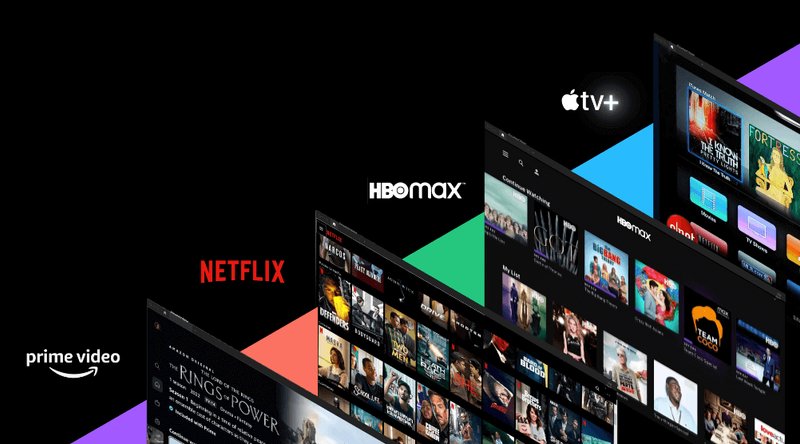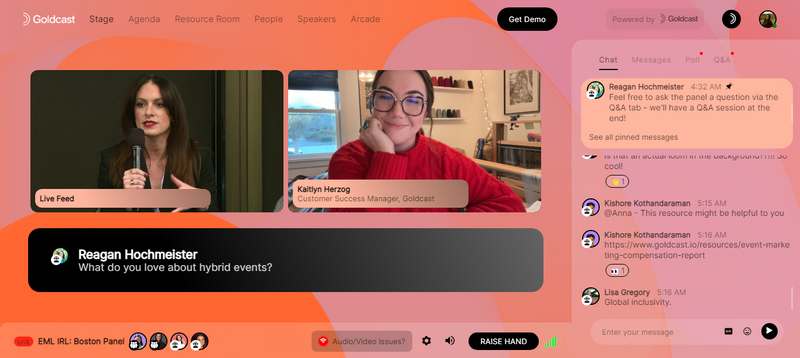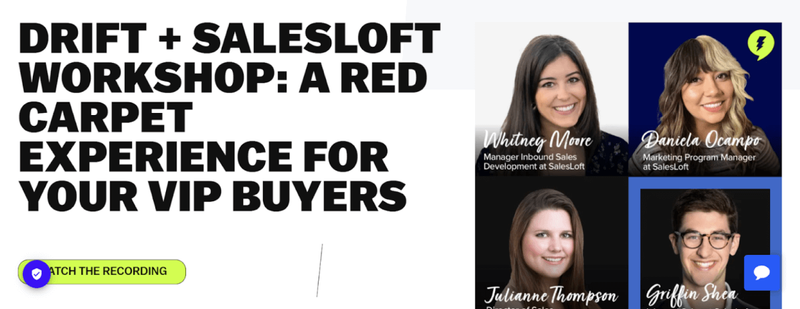Digital Event Strategy: 5 Tactics to Improve ROI in 2023

Maximize Your Marketing ROI
Join 10,000 other marketers already getting the best tips on running engaging events that boost pipeline and create raving fans.
Recently, I gave a talk for Demandbase's SMART Showcase. We talked about how the industry has changed and what successful companies are doing these days to maintain and grow their customer base.
Think back to pre-pandemic times. What do you think of when you recall a 2018 or 2019 webinar? Probably pretty hard to even remember, right? But if you do have any memory of it, it's probably a foggy recollection of a boring, unengaging webinar—and that was standard for the times!
Things sure have changed, and there are a few major societal shifts driving these shifts.
High-quality content, short-term gratification, and everything on-demand
The three major changes I want to talk about didn't start with the pandemic; they've been happening over the last decade.
First, streaming platforms have made it the norm for consumers to easily access high-quality, bingeable content. Think: Netflix, HBO Max, Apple TV. They know exactly how to keep us hooked and coming back for more!

Next, people are gravitating toward short-term content. You've no doubt seen the rise of TikTok, which plays into this trend. Instagram and Twitter also tend to keep things pretty succinct. We know people have a lot of things competing for their attention, so all of this makes sense.
Finally, there's no doubt we've arrived in the age of convenience. Anything you want, you can order on demand—and you'll probably receive it within a day or two, if not sooner. We queue up food from DoorDash and grocery deliveries from Instacart and toiletries from Amazon Prime. While we can obviously still venture out to buy things, people really want to own that option of choosing their own experience and whether they have to do that.
So, how do these three trends—all arching toward making things easier and more convenient for consumers—affect your digital strategy and ROI?
The expectation for quality events has increased
Basically, people want better events. You can't just throw on a webinar you put on nine or ten years ago and expect it to do well. People know way too much to let that fly now! They simply won't engage, and it may undermine your relationship with your customer base.
Sometimes companies think what they need to do is organize more events, but that's not the move either. This isn't a numbers game—you definitely want to optimize for quality over quantity.
What do you do, then?
To answer that question, we looked at some Goldcast customers who have been very successful in driving pipeline and retention when it comes to their digital event strategy. Companies like Drift, Amplitude, Zora, and Lattice have a few patterns among them that have made their digital strategy successful.
Let's get into the five major tips we pulled after analyzing successful companies and their strategies!
#1. Pair digital events with in-person field experiences
Digital events are essentially content delivery at scale. One thing that's important to always remember is that this is the only channel that has any sort of real human touch.
If you look at other channels like chatbots, email marketing, or paid ads, there's no real, live human speaking to audience members. Digital events are the only channel that offers that.
That's not to say that all aspects of the human experience come easily to digital events. Networking can be quite challenging, for example. And this is why it makes sense to pair your digital events with an in-person component.

That's right: We urge you to bring your accounts together in various cities and have in-depth, meaningful conversations and discussions that simply aren't possible through digital-first events.
A good rule of thumb is:
- If your event has more than 30 people, focus on the digital experience.
- If your event has less than 30 people, have an in-person conference. That could be a roundtable discussion, a dinner, or any other face-to-face event.
Our customer, Lattice, does this really well. Their strategy is completely digital-first, and they do all of their webinars and annual conferences virtually. But they also do a series of roadshows across cities in very intimate settings, where they bring their accounts together and drive pipeline that way.
Our strategy next year is to be heavy on digital with a focus on city-based roadshows and dinners across cities to meet our target accounts.” - David Cain, CMO, Lattice
#2. Follow the 70/30 rule and include retention and expansion goals
It's become pretty clear over the last few years that net revenue retention (NRR) is a critical metric for companies. Public markets are rewarding companies that have an NRR of more than 120% because net retention correlates with growth and sales.
Another good rule of thumb, which we can call the 70/30 rule, is: Aim for 70% of your events to focus on net new pipeline and 30% to center around retention and expansion.
This means that while most of your resources are going toward net new pipeline, you want a significant chunk of your events working on retention and expansion. Companies like Drift, Bolt, and Amplitude nail this by hosting exclusive events for customers, where they provide product education and get feedback.
These closed-door settings allow customers to share their stories and learn more about the company roadmap. The companies also give away swag and gifts to make things fun!
The hope is that not only are you maintaining your accounts, but you're nurturing relationships that will eventually expand and do more business with your company.
Aim for 70% of your events to focus on net new pipeline and 30% to center around retention and expansion.”
#3. Foster communication between the events and campaigns teams
A lot of times, teams work in silos, including the events and campaigns team. This is a big mistake!
Events teams that work hand-in-hand with campaigns see a 20+% higher success in net new pipeline. This also cuts down on confusion and ensures things are in sync.
Think about it: It doesn't make a lot of sense for the events team to be unaware of what the campaigns team is planning to launch. If both teams know what the other is planning, they can come up with ideas to push from their own side to further the initiatives.
One cannot exist without the other. A large portion of what the events team needs is people to sign up and attend the event—and the campaign team knows exactly how to get those people there and get them engaged!
The bottom line: If your teams are operating in different settings, figure out ways to bring them together and make sure the lines of communication are open.
Events teams that work hand-in-hand with campaigns see a 20+% higher success in net new pipeline.”
#4. Co-host events with strategic partners
Lots of info to digest so far, right?
Next, we need to make sure you've got partners involved with your events. Beyond the obvious benefit of expanding your own network, partners can help carry the promotional load, aid in the go-to-market aspect, and bring down your costs.
You can leverage partners for digital events, sponsored industry events, and ancillary events. We've seen Drift and Salesloft do an exceptional job of hosting events that bring the community together and co-promoting to share costs and really get folks to come out to the event.

Think about potential partners who would add tremendous value from a technology and go-to-market perspective. Then, consider thoughtful ways you can reach out to those company leaders and talk about planning events together.
Partners can help carry the promotional load, aid in the go-to-market aspect, and bring down your costs.”
#5. Share valuable data ASAP with your sales team
The final tip is to make sure that you're providing the sales team with the data they need. They want info around highly qualified leads—not just who came to your event. Give them real data about Q&A, polls, comments, and time spent in the event.
Goldcast customers have a channel to do this through Slack and Salesforce integrations. That way, sales can be reached in the areas they sit, and they're kept updated in real-time. Salespeople can even join in on the events if they want!
Your sales professionals want to understand what their target accounts are doing, whether digitally or in person. They need context so they can have more relevant conversations with their customers and prospects. If you can set up a workflow to do this, you'll empower your sales team and effectively drive pipeline.
Plan your 2023 strategy with these tips in mind
The impact that both the pandemic and technological advances have had on the digital events industry cannot be overstated.
To recap our advice: Add an in-person component to appropriate digital events, allocate some budget toward retention, make sure your events and campaigns teams are communicating, co-host events with partners, and share data with your sales team.
As you're planning for 2023, keep these five things in mind and watch your event ROI skyrocket over the next few years!

Transform Your Video Marketing with AI
Stay In Touch
Platform
Resources
© 2025 Copyright Goldcast, Inc. All rights reserved.





 Upcoming Events
Upcoming Events Event Series
Event Series On-Demand Events
On-Demand Events

